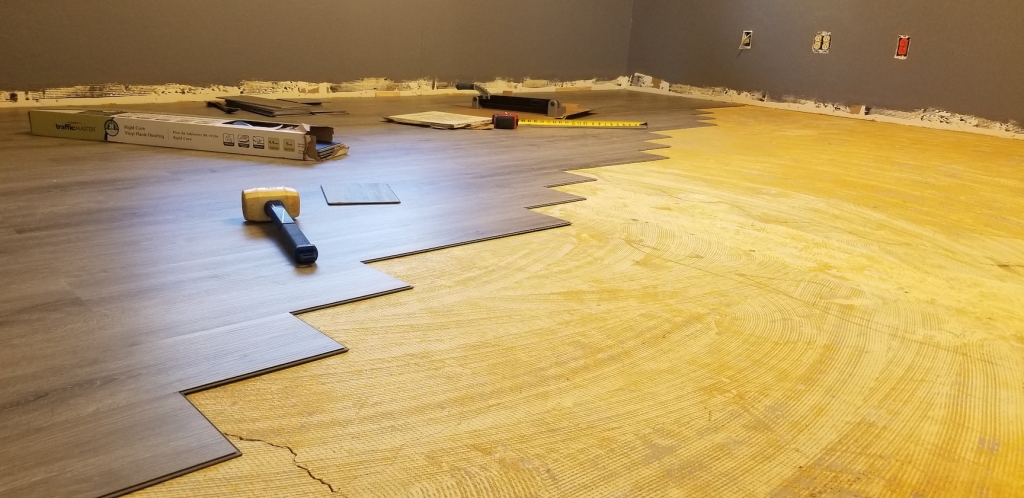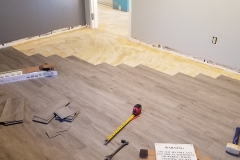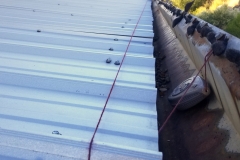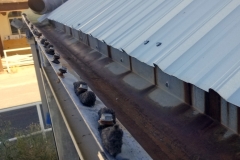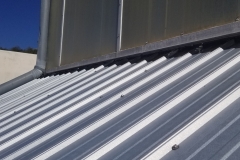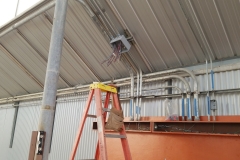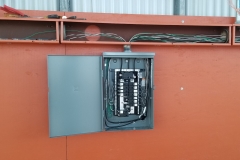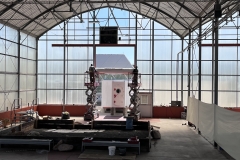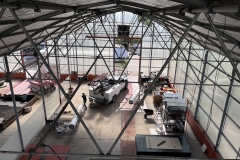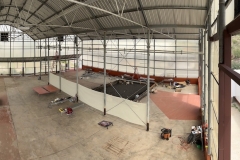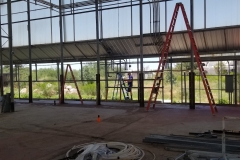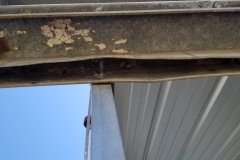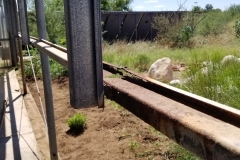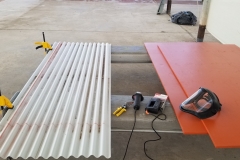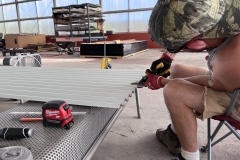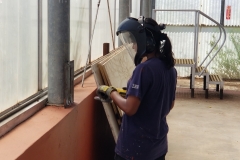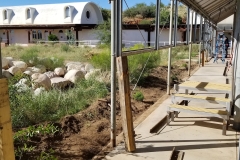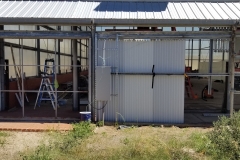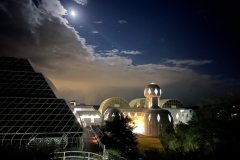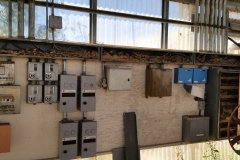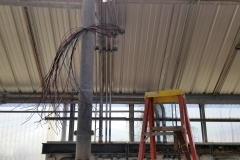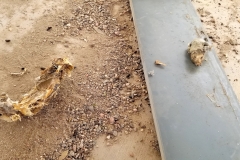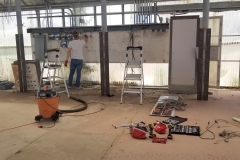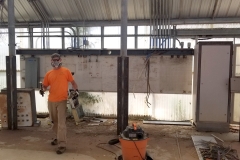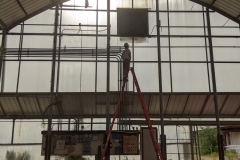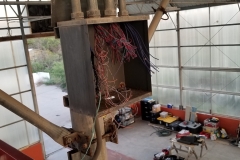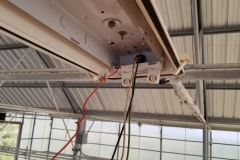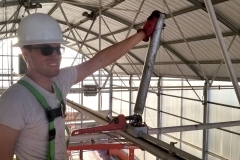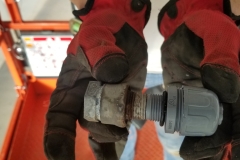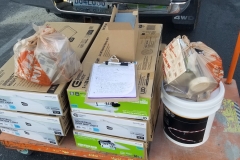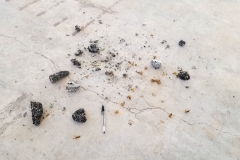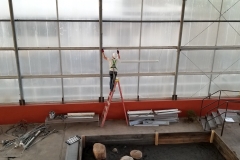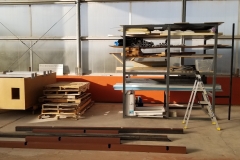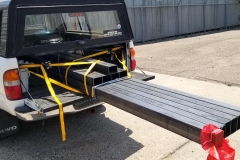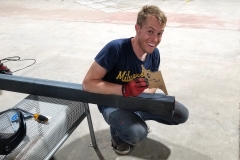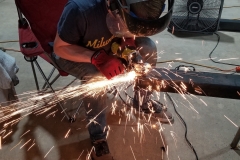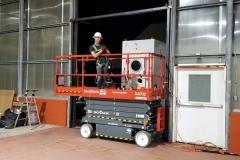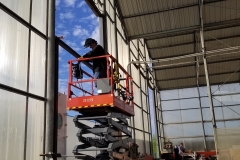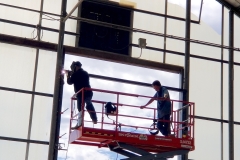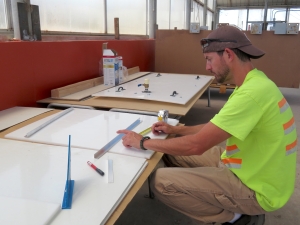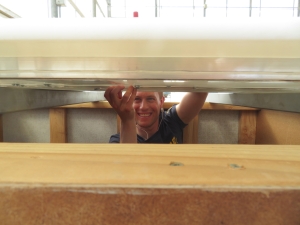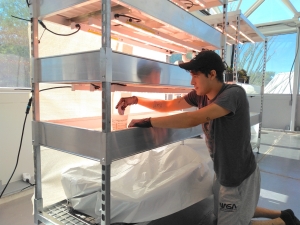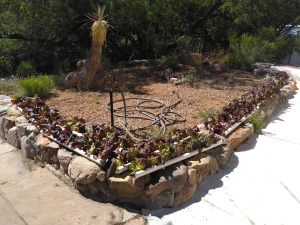Primary renovation of the Mars yard superstructure is done
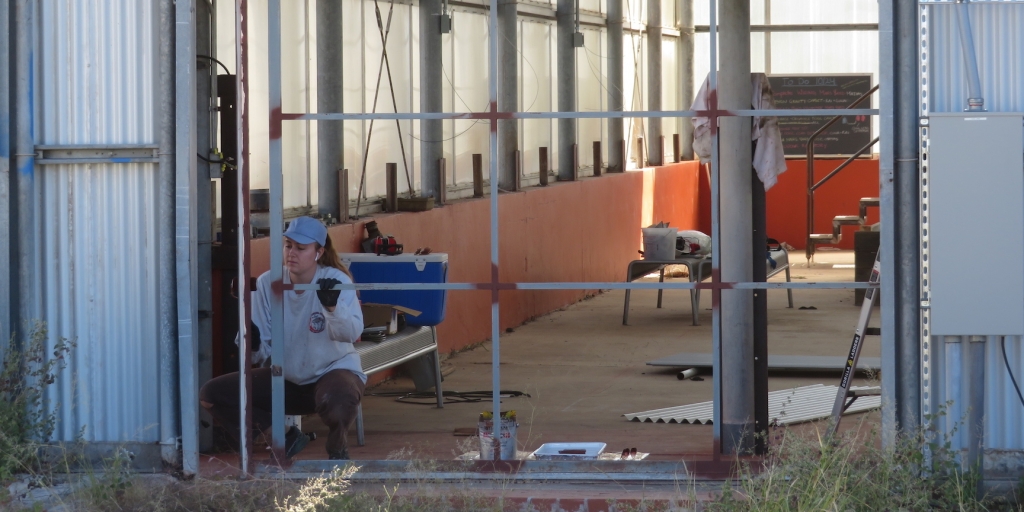
Last week Matthias and Luna built a quick prototype of a Mars yard wall section, the intent to visualize the avrage height and angle of a small section of what will be sculpted concrete over expanded steel. With the close of this week Matthias installed the final sheet of steel paneling on the sliding door then trimmed west wall roof sheets (installed in July 2022) while Luna painted, and Kai installed the new power distribution panel.
It’s been a long, hot summer followed by a far too warm September and October with a series of projects in the SAM Mars yard renovation that took far more resources than anticipated. With Matthias Beach in the lead, Sean Gellenbeck, Tasha Coelho, Mason Robbins and Natasha Nichols worked sequentially for the removal of all no-longer-needed electrical conduit, chasing new electrical wiring through the conduit that was retained, installation of a new electrical power distribution panel, mounting all new, outdoor rated electrical sockets, replacing the mostly defunct lighting (as one would expect after thirty five years), and a complete reconstruction of the west wall in order to install new steel siding.
The end result is incredibly rewarding as the Mars yard superstructure is very well lit, with isolated circuits on every wall, and a clean power distribution panel on a brand new backboard. With the new roll-up doors and steel roof overhead, the building is now completely secured from the weather, and from the critters too.
A little organization goes a long way
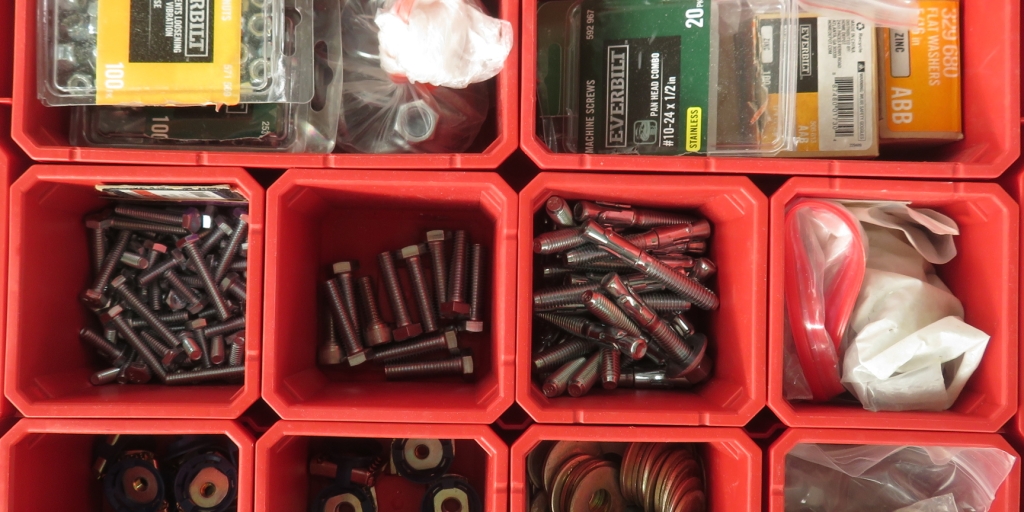
If one on my team members asks for the whereabouts of a tool more than once, then we have a breakdown in our organizational system and are wasting time. Stop and fix the system!”
Small, well organized teams can run circles around a larger, comparable entities, especially when their overhead is low and assets are well managed. Small teams respond to changing environments with less drag, and set course corrections by direction of a single leader or a raise of hands. But the means by which any size team organizes its “stuff”, analog and digital, determines if it holds accumulating assets or a growing burden.
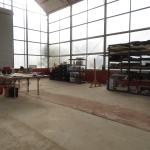 SAM started with Kai Staats, Trent Tresch, a broom, two angle grinders and a face shield, two orbital sanders and a box of sand paper. Fast forward nearly three years and SAM is defined by a half acre of land, some 9,000 square feet in building space, and ample tools and supplies to fabricate just about anything in wood, plastic, or metal.
SAM started with Kai Staats, Trent Tresch, a broom, two angle grinders and a face shield, two orbital sanders and a box of sand paper. Fast forward nearly three years and SAM is defined by a half acre of land, some 9,000 square feet in building space, and ample tools and supplies to fabricate just about anything in wood, plastic, or metal.
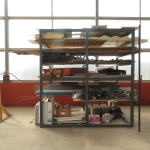 While we have maintained a regimen of organization, returning tools to their respective bins each evening and conducting a total inventory with the close of each week, we made due with the funds raised in each phase of development. We used plastic bins for tool storage and unused sheets of steel covered with cardboard as our workbench, just inside the north bay door of the Mars yard structure.
While we have maintained a regimen of organization, returning tools to their respective bins each evening and conducting a total inventory with the close of each week, we made due with the funds raised in each phase of development. We used plastic bins for tool storage and unused sheets of steel covered with cardboard as our workbench, just inside the north bay door of the Mars yard structure.
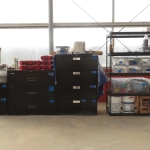 With advanced funding secured in July we saw an opportunity to improve our organization and related efficiency. We acquired a Husky mobile tool cart and a few more power tools to replace those yet on loan from our staff members. We gave new life to a discarded Biosphere 2 metal shop workbench topped with two sheets of recycled plywood. For us, this was a dream-come-true—our very own workbench and a dedicated tool cart.
With advanced funding secured in July we saw an opportunity to improve our organization and related efficiency. We acquired a Husky mobile tool cart and a few more power tools to replace those yet on loan from our staff members. We gave new life to a discarded Biosphere 2 metal shop workbench topped with two sheets of recycled plywood. For us, this was a dream-come-true—our very own workbench and a dedicated tool cart.
The half day spent in building the workbench paid for itself in the first week. With the complete re-organization of every tool, bolt, nut, and washer; every strand of wire, every plumbing fitting, and every tube of silicone (Thank you Luna!) have dedicated, labeled bins and drawers.
Walls, wiring, and wild things

“The bobcats at Biosphere 2 are anything-but-timid, curious, and clever. They watch us work by day and explore the Mars yard by night. When the work is overwhelming or the two-week task drags into its second month, its the wildlife that keeps us entertained and lighthearted.” — Kai Staats, Director of Research for SAM at Biosphere 2
The west wall of the original Biosphere 2 botanical garden Rain Forest Greenhouse, now our Mars yard and workshop, holds the power distribution for the entire facility. We’ve been working up to this point for a year and a half, with the removal of the old roof, installation of the new roof, and work this summer in July, and August and September.
This week saw the completion of the monumental west wall reconstruction, more than six weeks in the making. It required a systematic reassembly of the overhead load-bearing structure in order to insert the new corrugated steel wall panels into the overhead C-channel and against the steel base. After thirty years, some sections were so badly worn that we had to contract a local sheet metal shop to duplicate the exact profile and provide new pieces. All new plywood sheeting was installed to provide the backdrop for the new electrical panel and power distribution. With all new wire already in place, we will now complete the electrical wiring at each new socket and lighting.
From botanical garden to storage building to workshop and Mars yard, this former greenhouse has seen a variety of functions. And as with the TM and lung, the SAM team is once again breathing new life into old structures.
Leak Detection
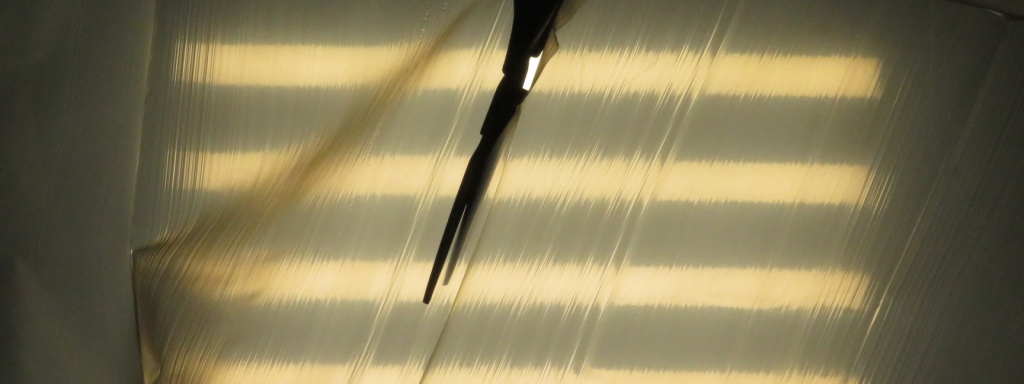
As with any pressure vessel, SAM has leaks. The current leak rate is higher than desired, therefore we are working to locate the holes, apply patches, and bring the total leak rate to a minimum. Our intent is to hold pressure for one week such that 6-day missions can pressurize the facility once, and with future, longer missions air will be added in a quantitative manner once each week, at most.
Recall that SAM has three modes of operation, where the first two missions were running in Mode 2, pressurized with flow-through air with a high degree of air quality monitoring, as noted in the data analysis. Inclusion II conducted two Mode 3 experiments in the course of their mission.
In the first part of June, Sean Gellenbeck and Matthias Beach isolated the lung from the rest of SAM, and then the lung and Test Module from the rest of SAM. In each instance they conducted a pressure test by raising the lung to roughly 36″, then closing the inlet valve and terminating the blower. The height of one of the eight lung feet was measured from the floor, and then again once each five minutes for one hour. The drop in height over time provides the total leak rate through the loss of the known column of air below the fixed diameter lung pan and membrane.
Leak rate = Pi * r^2 * drop (inches) * time (minutes)
While we do calculate the leak rate by volume of air, for ease of visualization we present it here instead as the loss in height of the lung.
With a max height just under 10 feet and a minimum height at zero, when one of the eight legs and feet touch the ground, the rate of descent is constant as the mass of the lung exerts the same pressure on the underlying column of air independent of its height. The temperature was measured with each height reading in order to provide raw height measurements and the height adjusted for temperature changes according to the ideal gas law.
The lung was found to have no significant leak rate, in fact, the lung rose during the one hour test due to a minor temperature increase. The lung and Test Module combined demonstrated a 1.3 inch lung drop per minute, or roughly 3.5 days sustained pressure if starting from the max height of 10 feet. The leaks in the Test Module will likely be readily corrected with a full application of silicone where two replacement windows were installed last spring.
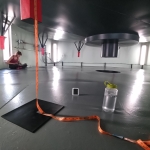 In the first and second week of October, Kai, Luna, and Natasha moved into the next important test—isolating the Engineering Bay (20 foot shipping container) from the Crew Quarters (40 foot shipping container) such that the lung, Test Module, and EB are treated as a single vessel.
In the first and second week of October, Kai, Luna, and Natasha moved into the next important test—isolating the Engineering Bay (20 foot shipping container) from the Crew Quarters (40 foot shipping container) such that the lung, Test Module, and EB are treated as a single vessel.
This proved to be a bit of a challenge as three electrical conduits, one fire detection conduit, and one water pipe run from the Engineering Bay into the Crew Quarters, making it very difficult to seal. It was determined that pulling all conduits was the simplest way forward. This included disconnection of the fire detection system, which required the UA Fire Marshall. Once the interface to the 20/40 bridge was clear of conduits, we sealed the far side with a plastic tarp and aluminum tape.
The lung, Test Module, and Engineering Bay combined demonstrated a leak rate of 0.1 inch lung drop per minute, or 19 hours sustained pressure if starting from the max height of 10 feet.
We have some work to do!
Close of Summer at SAM
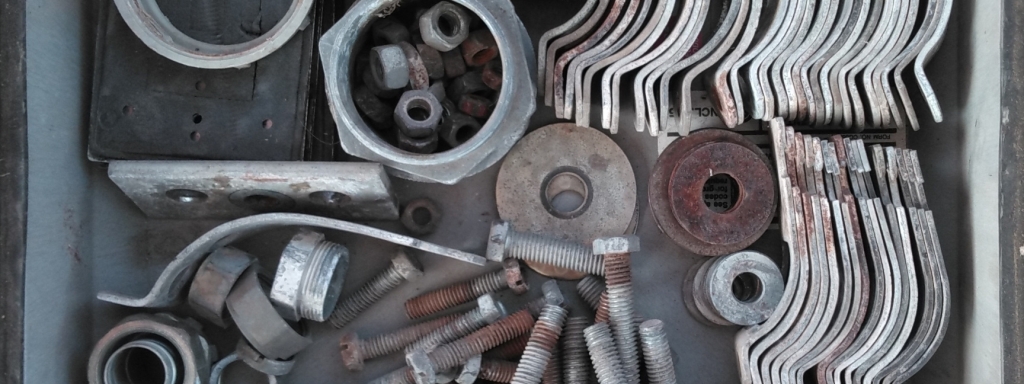
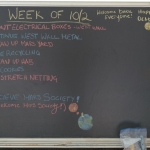 Through the intensity of a record breaking heat, Matthias, Sean, and Tasha, Mason and Natasha were steadfast in their summer-long effort in renovating the 1980s Biosphere 2 rain forest greenhouse into what will house the SAM Mars Yard and Terrain Park. When complete, the 2200 sq-ft sculpted concrete Mars crater will provide SAM crew members on EVA the physical sensation of moving over the varied terrain found on Mars, within a visually engaging representation of a crater.
Through the intensity of a record breaking heat, Matthias, Sean, and Tasha, Mason and Natasha were steadfast in their summer-long effort in renovating the 1980s Biosphere 2 rain forest greenhouse into what will house the SAM Mars Yard and Terrain Park. When complete, the 2200 sq-ft sculpted concrete Mars crater will provide SAM crew members on EVA the physical sensation of moving over the varied terrain found on Mars, within a visually engaging representation of a crater.
The primary efforts this summer were:
- Pull all existing electrical wiring.
- Remove all electrical conduit that will not be used again.
- Rebuild the electrical panel on the west wall.
- Run all new electrical wiring, installing new circuits such that electrical sockets are readily available on all four walls and down the central support beams, with consideration for continued use of the workshop and future Mars yard where fans, lights, and cameras will be employed during crew EVAs and rover competitions.
- Rebuild the entire west wall, replacing all fiberglass paneling with corrugated sheet metal siding.
- Install two roll-up garage doors on the east wall of the structure.
- Replace all polycarbonate panels on the east and west walls (to be completed).
As with all remodels, it always takes longer than anticipated. But if we knew how much work these endeavors would be, we’d probably never start for the overwhelming nature of what laid ahead.
A journey through space and time
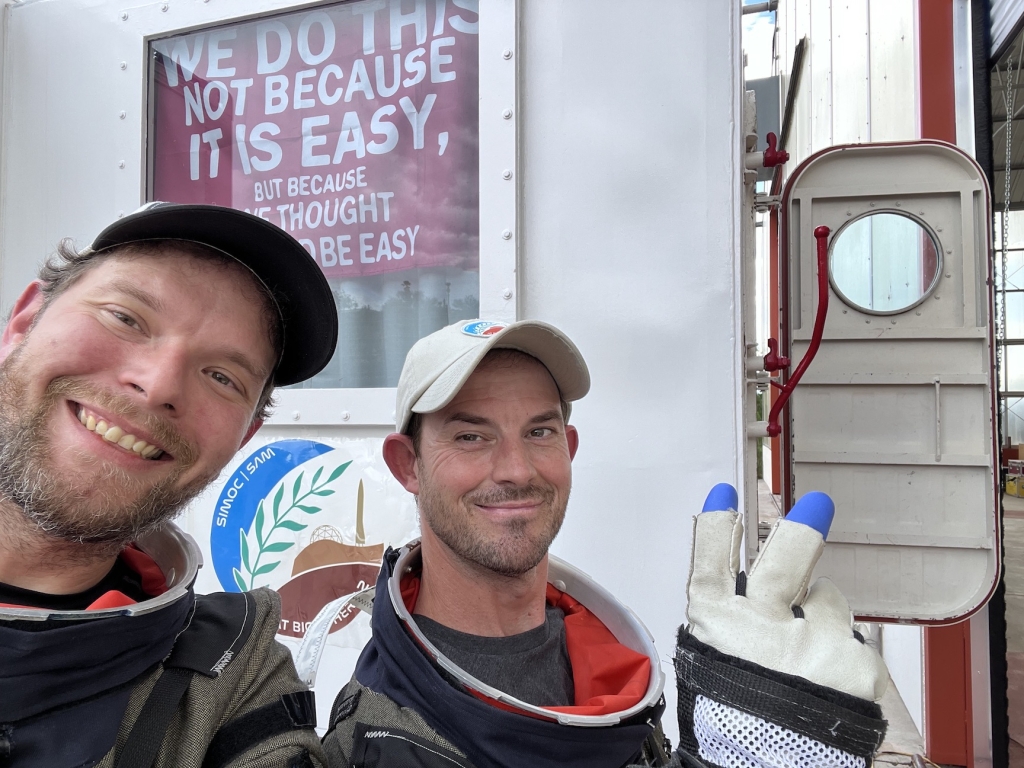
by Mason Robbins
In a quiet corner of the historic Biosphere 2 campus, a team of dedicated individuals continues their mission, now in progress for nearly three years. SAM (Space Analog for the Moon and Mars) is expanding to include a massive indoor Mars yard, a terrain park that works to replicate the harsh environments of the red planet right here on our own planet Earth. Over the past several weeks, they’ve made remarkable progress in bringing the massive, indoor SAM Mars yard to life.
Join us on a journey through time and space as we delve into the captivating narrative of their ongoing work … with photos coming soon!
The Journey Resumes (Week of 7th August 2023)
With three years of dedicated effort behind them, the team carried on work at SAM, ready to take their project to the next level. Their first task was to untangle the complex web of electrical wires and conduit that had evolved over time. With precision and patience, they meticulously labeled and toned out 95% of the wires, bringing a sense of order to the chaos. The quarter-steel wings that lined the support posts were given attention, as sanding commenced, preparing them for future use. A trip to Home Depot was on the agenda, with Kai picking up essential parts for the upcoming phases. Work on the yard’s electrical blueprints began to take shape.
Crafting the Foundation Anew (Week of 14th August 2023)
The team approached their tasks with a deeper understanding of the project’s intricacies. They set out to complete the sanding and priming of bay door headers, now with a well-honed technique. Unneeded conduit and wire were removed, further simplifying the yard’s layout. Electrical backboards received the sand-prime-paint treatment, ensuring they would stand up to the challenges ahead. Collaboration with Kevin, the electrician, yielded progress on J-box placements and switch wire toning. Another Home Depot visit followed, expanding the growing parts list. On the east wall, electrical preparations were made for the removal and installation of new poly panels. The steel for the west wall arrived and was carefully offloaded and stacked.
Assembling the Pieces with Seasoned Expertise (Week of 21st August 2023)
The team supervised and assisted the C&D doors team as they embarked on the installation of two bay doors. Backboards and frames received their finishing touches with a fresh coat of paint. An electrical junction box was installed on the west wall, accompanied by the meticulous process of re-labeling wires. Conduit and wire that had outlived their purpose were removed, streamlining the setup. Plans for J-box cut-ins and a 3-way switch were laid out with Kevin. A meeting with the general contractor regarding crater walls and poly panel installation shed light on the project’s broader scope. New drawings were created to assist poly installers with roof measurements, and parts runs to Home Depot continued. Meanwhile, a unique challenge presented itself as the team battled a persistent wasp population.
Pushing the Boundaries with Three Years of Wisdom (Week of 4th September 2023)
As they pressed onward, the team leveraged their experience, their focus on the west wall, and the intricate task of fitting panels within the c-channel guided by Kai’s expertise. Multiple visits to metal fabrication shops ensued, driven by the need to re-manufacture horizontal support beams. Abbott Metal Fab emerged as a potential partner, with a template beam dropped off for a quote. Home Depot remained a reliable source for parts, as the team worked to make electrical piping align with the new panels. East and North Wall Power boxes were mounted with precision. Conduit runs that obstructed progress were ruthlessly removed, and updates were shared with Kai through photos and emails.
As we reflect on these past three years of intense effort and dedication, it’s evident that the SAM project is not just about creating a physical space analog; it’s about the meticulous planning, collaboration, and relentless pursuit of perfection that will eventually propel humanity to new frontiers. Each day brings new challenges and discoveries, and as the SAM team continues to work tirelessly, they inch closer to realizing their dream of simulating the conditions of Mars right here on Earth. Stay tuned for more updates as we follow this incredible journey through space and time.
Mars yard takes form
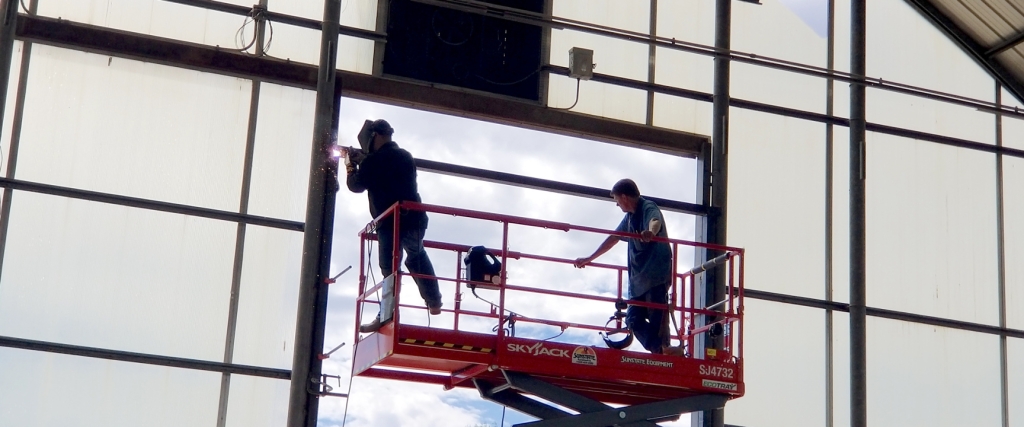
Following six months straight construction, the Analog Astronaut Conference and two sealed missions, the SAM crew took a much needed break. With the close of May, Matthias Beach, a space enthusiast with a background in the military and telco moved from volunteer to staff to head up the continued construction of the SAM Mars yard.
This 6400 square-foot facility was in the late ’80s and early ’90s the rain forest greenhouse for Biosphere 2. It served as a staging facility for the Landscape Evolution Observatory (LEO) more than a decade ago but has sat mostly empty since. The roof panels had fallen to ruin and were removed by Kai, Tim, Colleen, and Luna in the spring of 2022. A new roof was installed that July. In the final days before the first sealed mission at SAM, Matthias and Tasha completed the construction of a prototype Mars yard in miniature, in which both crews of four were able to explore in a pressurized suit during their respective EVAs. The Inclusion I and Inclusion II crews demonstrated the value of such a facility, even in its then simple, sandbox form.
Now, the effort is expanded to completely gut the original electrical wiring, remove all unused conduit and support structures that once gave greenhouse heaters purchase; replace the florescent lights with modern, brighter LED panels; install roll-up garage doors in each bay, and by the close of the year, install a massive sculpted, hand-painted, synthetic rock Mars crater!
Matthias Beach and Sean Gellenbeck have taken on this arduous task in the peak heat of the Arizona summer, having to remove a small army of skeletons (literally) while fighting a never ending battle with very aggressive wasps (sometimes the wasps win; sometimes the humans). The past six weeks are captured, in brief, in these twenty photos.
A much needed break
The turtles that snip at the heals of the chipmunks that spin the wheels that wind the springs that drive the automatons to write the essays that accompany the photos taken by the unsung heroes of the Fourth Planet Revolution are, for what may feel like an eternity to you who wait patiently, taking a break.
Construction of the full Mars yard commences with the first week of June. However, updates to this forum will be shared a little less frequently than in the prior phase due to all efforts to slow the Earth’s rotation and thereby increase the productive hours in day having failed. As such, said heroes of the Revolution, automatons, chipmunks, and turtles will be unable to process, color correct, and publish associated photo essays in the course of these not-long-enough summer days.
Debrief, reset, and upgrade
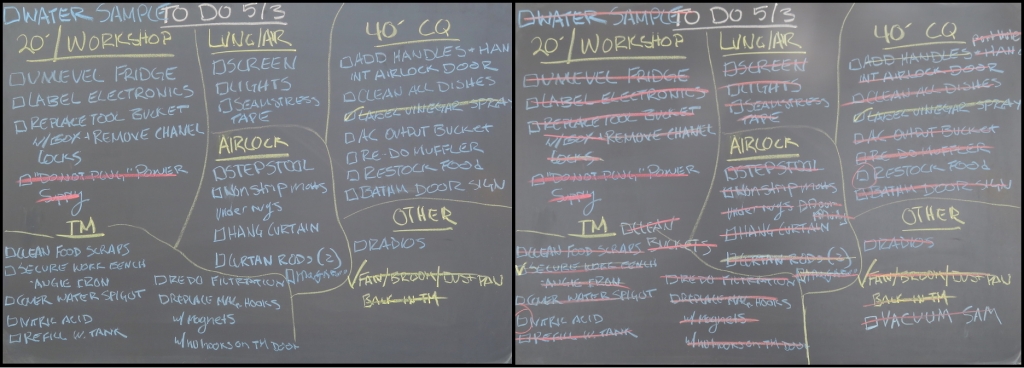
Shortly after their exit from the very first six days mission at SAM, crew Inclusion I met with Director of Research Kai Staats and his team for a debrief. Stories were shared, lessons were learned, and both crews came away with understanding for what worked, and the ways in which future missions could be improved.
The very next day, May 3, Kai and the SAM crew went to work, completing a total cleaning of the facility, including linens (thank you Kai’s mother and father), reset of the food supplies, and several physical upgrades to the facility including the addition of a Magnehelic pressure gauge on the outside of the airlock for improved visibility and safety, the addition of a middle set of handles on the interior airlock pressure door, fabrication of a new out-bound air filter for improved air flow, an all new water filtration system, the addition of an “OCCUPIED” sign on the bathroom door, resetting the hydroponics (thank you Atila), hanging a curtain at the end of the airlock as that space was used as a changing room, and replacing the tool bucket with a proper tool box and a greater assortment of tools, to name a few.
Thank you Inclusion I for your honest feedback! And thank you SAM Crew for your impressive one-day turn-around!


